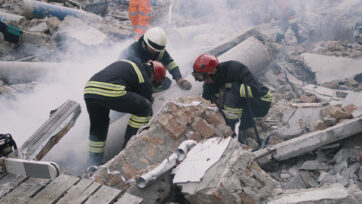Illustrative image (Credit: pb press/Adobe Stock)
A catastrophic systems failure on July 30 brought the UK’s air traffic network to a standstill, grounding flights across the country and stranding hundreds of thousands of passengers. The outage, traced to a radar data synchronization glitch at the UK’s National Air Traffic Services (NATS), affected screens used by air traffic controllers to safely monitor and route aircraft. The failure exposed serious vulnerabilities in the nation’s critical infrastructure systems, with ripple effects across the European airspace.
Nationwide Ground Stop
The glitch began at approximately 2:30 p.m. local time and quickly propagated through key control centers, including those serving Heathrow, Gatwick, Manchester, Stansted and Luton. In total, over 3,000 flights were impacted, with delays and cancellations affecting approximately 577,000 passengers. Many international flights were forced to divert mid-air or return to their origin.
Several passengers described hours of waiting on tarmacs without clear communication.
“The captain said they had no radar visibility and had to wait for clearance,” one traveler on a Heathrow-bound flight from Munich recalled.
What Happened:
- 2:30 p.m., July 30: Anomalous data had entered the radar system, causing cascading software errors
- 3:15 p.m: Heathrow, Gatwick, and other airports issued stop orders on outbound flights
- 4:00–8:00 p.m.: Over 2,000 flights were delayed or grounded. Arriving aircraft were held or diverted
- 11:00 p.m.: NATS reported partial restoration. Full recovery occurred the next morning
- August 1: The UK CAA confirmed an investigation, and EU coordination began for a shared airspace review.
Systems Breakdown: What Failed?
NATS initially attributed the incident to a “technical issue” before confirming it stemmed from corrupted radar metadata that entered the flight plan processing system. The system failed to reject or isolate the anomalous data entry, triggering a cascade of failures across backup nodes.
While no aircraft crashes or near misses occurred, controllers were forced to restrict flight volumes and impose manual separation, reverting to pre-digital safeguards not used at this scale in decades. This not only slowed operations but also highlighted the lack of robust redundancy in digital air traffic infrastructure.
Engineers are now investigating why the system lacked:
- Data validation buffers for corrupt inputs
- Isolated environments for faulty packets
- Real-time rollback or versioning for critical software layers.
Systemic Risks of Digitized Infrastructure
The incident follows a pattern of increasingly complex and brittle infrastructure systems failing under unexpected input or load. Experts warn that critical systems designed decades ago are now being pushed beyond their original tolerances, without corresponding upgrades to fault detection or failure isolation layers.
Aviation regulators in the UK and EU have long warned of over-dependence on legacy digital platforms, many of which are maintained through patch-based updates due to funding gaps and procurement delays.
What Does Systems Engineering Teach Us Here?
“Was this just a glitch? Or was it a governance blind spot with technical symptoms?” — Robert Halligan
Unlike a failure of equipment, the UK radar outage represents a failure of system stewardship. When critical infrastructure becomes dependent on silent, unseen digital processes, the absence of robust design protections and cross-boundary checks creates latent risks that only surface under pressure.
From a systems engineering standpoint, this event illustrates what happens when a complex system outpaces the systems thinking behind its development.
Air traffic control systems, like many digital-era platforms, now rely on the real-time choreography of multiple data streams, interfaces and fallback protocols. Yet here, the choreography broke, not because of one corrupted data input, but because the wider system lacked choreography for failure.
Five Systems Engineering Lenses on the NATS Failure
Assumptions in architecturing: Was the system designed assuming perfect inputs? Systems engineering practitioners would ensure the design was resilient to garbage-in conditions.
Boundary Protection: Were malformed inputs allowed to bypass filters and reach core functions? A boundary-first design would quarantine such data.
Resilience Engineering: Was there graceful degradation, or did the system collapse as a monolith? Decentralized architectures can help isolate risk.
Human-System Integration: Were air traffic controllers equipped with transparent system status cues, or left interpreting failure through silence?
System Lifecycle Governance: Was there a plan for managing legacy platforms as infrastructure aged, or had the system quietly become too critical to fail, but too brittle to adapt?
This was not a failure of engineering alone, but of engineering oversight, a reminder that without active lifecycle governance, yesterday’s robust systems can quietly become tomorrow’s single points of failure.
Regulatory and Public Trust Implications
The UK’s Civil Aviation Authority has launched a formal investigation. Meanwhile, public pressure is mounting for both NATS and government regulators to publish timelines for full infrastructure audits and upgrades. Questions remain about:
- Why such a critical system lacked robust isolation mechanisms and rollback
- Whether commercial or political pressures delayed necessary modernization
- How future incidents will be mitigated without significant systemic investment.
Looking Ahead
The radar glitch marks the largest UK air traffic disruption since the 2010 Eyjafjallajökull volcanic eruption. But unlike a natural event, this disaster was man-made and preventable.
For engineers, policymakers, and infrastructure managers, it underscores the urgency of:
- Proactive audits of digital infrastructure
- Investment in software architecture modernization
- Clear failure containment protocols
- Cross-sector trials and simulations for rare, high-impact digital failures.
A Closing Note
Critical systems—from radar to hospitals, financial networks to water treatment—are growing ever more interconnected and vulnerable to single points of failure. The UK radar outage serves as a sobering example of how invisible dependencies can give rise to catastrophic failures within minutes, if the system is not designed with resilience at its core.
References:
Leake, Jonathan 2025, ‘Heathrow shutdown blamed on catastrophic failure in national grid’, The Telegraph, viewed 1 August https://www.telegraph.co.uk/business/2025/07/02/heathrow-shutdown-blamed-catastrophic-failure-national-grid
UK Civil Aviation Authority 2025, ‘Flight disruption caused by NATS technical issue’, CAA, viewed 1 August 2025, https://www.caa.co.uk/passengers-and-public/resolving-travel-problems/30072025-flight-disruption-caused-by-nats-technical-issue
Reuters Staff 2025, ‘UK airports disrupted by radar fault in air traffic control system’, Reuters, viewed 1 August 2025, https://www.reuters.com/world/uk/uk-airports-disrupted-by-radar-fault-air-traffic-control-system-2025-07-30/
























